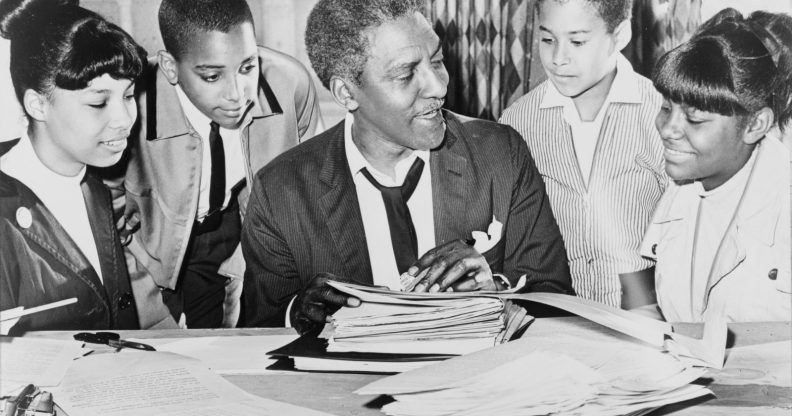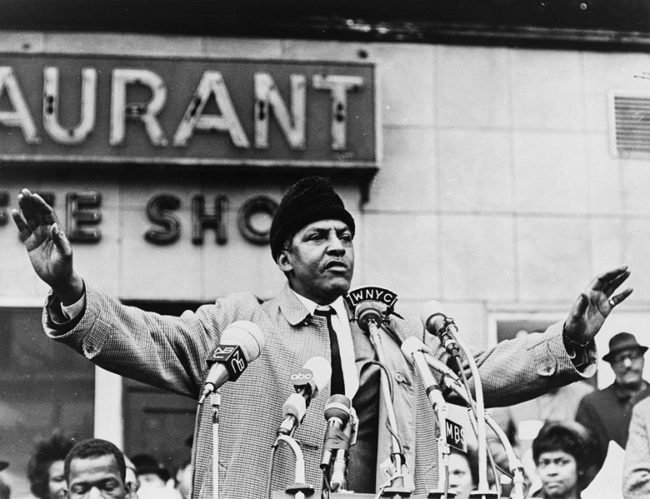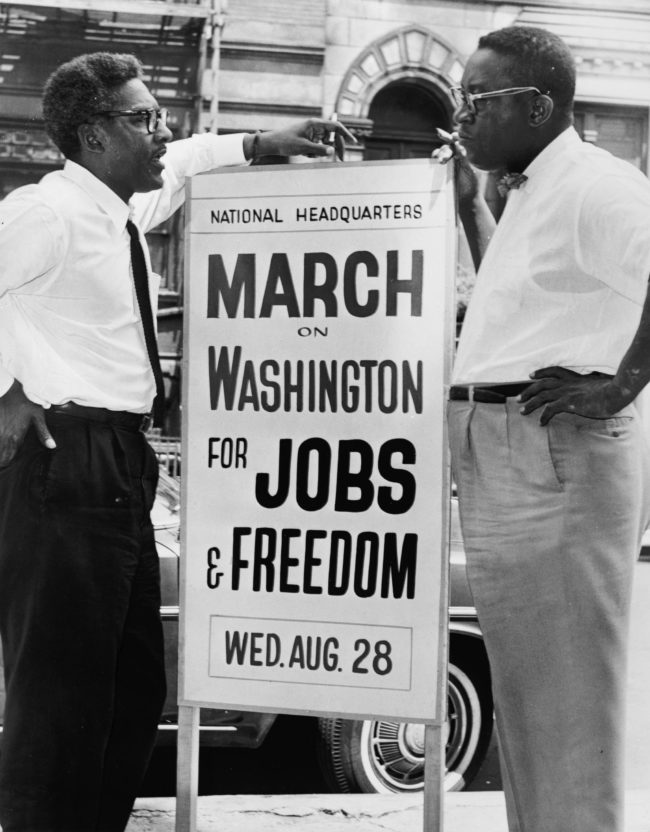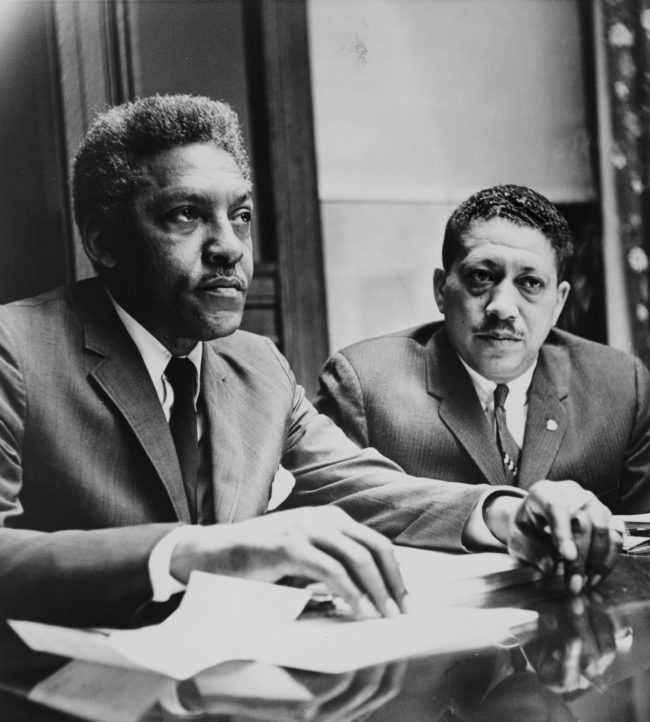More people should know about Bayard Rustin – Martin Luther King’s trailblazing Black, gay advisor

Bayard Rustin.
Bayard Rustin, the influential gay Black advisor who inspired Martin Luther King Jr., was an American leader in social movements for civil rights, socialism, nonviolence and gay rights, however he was kept in the shadows by the Civil Rights movement establishment due to his sexuality.
Bayard was also a chief strategist for MLK’s landmark March on Washington.
Born in West Chester, Pennsylvania on March 17, 1912, Bayard was arrested several times for civil disobedience and open homosexuality.
He was a fearless campaigner for equality, and used his voice to enable a fight for equality which earned him a place in history.
At the end of his life in the political spotlight he said: “The major lesson I had learned in fighting for human rights for 50 years for people all over the world… is simple.
“No group is ultimately safe from prejudice, bigotry, and harassment so long as any group is subject to special negative treatment.”
His upbringing
The activist was raised by his grandparents Julia and Janifer Rustin, although he was brought up in the belief that they were his parents. His older sibling Florence was actually his mother, while his father was West Indian immigrant Archie Hopkins.
Bayard had a good education. He studied at Wilberforce University in Ohio and Cheyney State Teachers College in Pennsylvania before moving to New York in 1937, where he studied at City College of New York.
He had a keen interest in politics, and joined the Young Communist League for a short period of time in 1936, before becoming disillusioned with the party.
Political stance

Bayard’s personal philosophy is said to have been inspired by the non-violent resistance taught by Mahatma Gandhi, also known as Quaker pacifism, and the socialism taught by American labor movement leader A Philip Randolph.
He worked for Randolph, who was also his mentor, during WW2, where he fought against racial discrimination in hiring for the war.
Bayard was a prominent activist in the early civil rights movement of the 1940s, promoting equality in the workplace and social schemes including the Freedom To Ride scheme to challenge segregation on interstate buses.
He was also involved in several pacifist groups, including the religious nonviolence group the Fellowship of Reconciliation.
In 1944, after refusing to fight in the war due to his nonviolent Quaker faith, he was imprisoned as a conscientious objector.
It wouldn’t be the activist’s first brush with the law – he was also arrested in 1946 in North Carolina when he protested against the segregated public transit system. He was sentenced to work on a chain gang (a group of convicts chained together while working).
“The principal factors which influenced my life are 1) nonviolent tactics; 2) constitutional means; 3) democratic procedures; 4) respect for human personality; 5) a belief that all people are one” – Bayard Rustin
Then in 1953, Rustin was arrested in Pasadena, California, when he was caught having sex with two men in a parked car. He was jailed for 60 days after pleading to a morals charge.
Martin Luther King and the March on Washington

By the 1950s, Bayard was an expert in organising human rights protests, which led him to his most famous encounter. The activist met Martin Luther King Jr. and started working with him as an organiser and strategist in 1955.
Bayard became a key voice in the civil rights movement. Most famously, he played a key part in organising the March on Washington for Jobs and Freedom on August 28, 1963, where King gave his legendary “I have a Dream” speech.
The March on Washington raised the profiles of black Americans who were still experiencing racial inequality in the workplace 100 years after emancipation.
Bayard also assisted King with the boycott of segregated buses in Montgomery, Alabama in 1956, and taught King about Gandhi’s non-violent resistance philosophy.
Of the March on Washington, Rustin said: “What you have to understand is that the march will succeed if it gets 100,000 people – or 150,000 or 200,000 or more – to show up in Washington.
“It will be the biggest rally in history. It will show the Black community united as never before – united also with whites from labor and the churches, from all over the country.”
An estimated 250,000 turned up.
Later work and personal life

In 1965, Rustin and his mentor Randolph co-founded the A Philip Randolph Institute – an educational, civil rights and labor organisation based in New York.
Rustin also continued his work within the civil rights and peace movements, and spoke about the need for social rights for gays and lesbians. He also received various awards and honorary degrees throughout his career.
His writings about civil rights were published in the collection Down the Line in 1971 and in Strategies for Freedom in 1976.
Little is known about Bayard’s personal life. However, in 1977, Bayard met Walter Naegle, who now acts as executive director of the Bayard Rustin Fund. The pair were together for 10 years, until Rustin died of a ruptured appendix in New York City on August 24, 1987, at the age of 75.
Commenting on Rustin’s death, Roy Innis, national chairman of the Congress of Racial Equality, said: “Bayard Rustin was a planner, a coordinator, a thinker.
“He influenced all of the young leaders in the civil rights movement, even those of us who did not agree with him ideologically.”
On November 20, 2013, President Barack Obama posthumously awarded Rustin the Presidential Medal of Freedom. It was accepted by Walter Naegle.
“In my statement I cited the major lesson I had learned in fighting for human rights for 50 years for people all over the world. That lesson is simple: no group is ultimately safe from prejudice, bigotry, and harassment so long as any group is subject to special negative treatment” – Bayard Rustin

